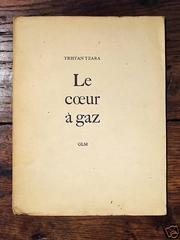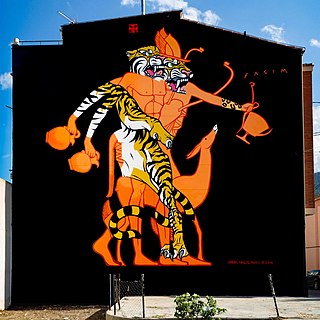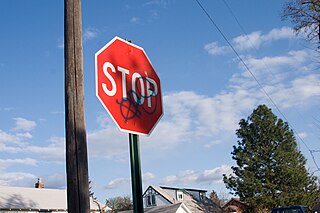
Dada or Dadaism was an anti-establishment art movement that developed in 1915 in the context of the Great War and the earlier anti-art movement. Early centers for dadaism included Zürich and Berlin. Within a few years, the movement had spread to New York City and a variety of artistic centers in Europe and Asia.

Graffiti is writing or drawings made on a wall or other surface, usually without permission and within public view. Graffiti ranges from simple written "monikers" to elaborate wall paintings, and has existed since ancient times, with examples dating back to ancient Egypt, ancient Greece, and the Roman Empire.

Tristan Tzara was a Romanian avant-garde poet, essayist and performance artist. Also active as a journalist, playwright, literary and art critic, composer and film director, he was known best for being one of the founders and central figures of the anti-establishment Dada movement. Under the influence of Adrian Maniu, the adolescent Tzara became interested in Symbolism and co-founded the magazine Simbolul with Ion Vinea and painter Marcel Janco.

Site-specific art is artwork created to exist in a certain place. Typically, the artist takes the location into account while planning and creating the artwork. Site-specific art is produced both by commercial artists, and independently, and can include some instances of work such as sculpture, stencil graffiti, rock balancing, and other art forms. Installations can be in urban areas, remote natural settings, or underwater.

Sticker art is a form of street art in which an image or message is publicly displayed using stickers. These stickers may promote a political agenda, comment on a policy or issue, or comprise a subcategory of graffiti.

Street art is visual art created in public locations for public visibility. It has been associated with the terms "independent art", "post-graffiti", "neo-graffiti" and guerrilla art.

Stencil graffiti is a form of graffiti that makes use of stencils made out of paper, cardboard, or other media to create an image or text that is easily reproducible. The desired design is cut out of the selected medium and then the image is transferred to a surface through the use of spray paint or roll-on paint.

A number of words and phrases that have come to describe different styles and aspects of graffiti and its subculture. Like other jargon and colloquialisms, some of these terms may vary regionally, taking on different meanings across different cities and countries. The following terminology originates primarily in the United States.
Civilian is the pseudonym of Tom Civil a street artist, operating out of Melbourne, Australia, who has been profiled as a "leading player" of "the city's vibrant stencil art scene".
Vexta is an Australian stencil artist and street artist from Melbourne, Victoria.

Melbourne, the capital of Victoria and the second largest city in Australia, has gained international acclaim for its diverse range of street art and associated subcultures. Throughout the 1970s and 1980s, much of the city's disaffected youth were influenced by the graffiti of New York City, which subsequently became popular in Melbourne's inner suburbs, and along suburban railway and tram lines.

The Gas Heart or The Gas-Operated Heart is a French-language play by Romanian-born author Tristan Tzara. It was written as a series of non sequiturs and a parody of classical drama—it has three acts despite being short enough to qualify as a one-act play. A part-musical performance that features ballet numbers, it is one of the most recognizable plays inspired by the anti-establishment trend known as Dadaism. The Gas Heart was first staged in Paris, as part of the 1921 "Dada Salon" at the Galerie Montaigne.

Urban art combines street art, guerrilla art, and graffiti and is often used to summarize all visual art forms arising in urban areas, being inspired by urban architecture or present urban lifestyle. Because the urban arts are characterized by existing in the public space, they are often viewed as vandalism and destruction of private property.

Yarn bombing is a type of graffiti or street art that employs colourful displays of knitted or crocheted yarn or fibre rather than paint or chalk. It is also called wool bombing, yarn storming, guerrilla knitting, kniffiti, urban knitting, or graffiti knitting.

Graffiti is writing or drawings scribbled, scratched, or sprayed illicitly on a wall or other surface in a public place. Graffiti ranges from simple written words to elaborate wall paintings. Graffiti, consisting of the defacement of public spaces and buildings, remains a nuisance issue for cities.

Dan Witz is a Brooklyn, NY based street artist and realist painter. He grew up in Chicago, IL, and graduated in 1981 from Cooper Union, on New York City's Lower East Side. Witz, consistently active since the late 1970s, is one of the pioneers of the street art movement.

Graffiti in New York City has had a substantial local, national, and international influence.

Graffiti in Iran consists of different styles. Some are slogans painted by governmental organizations, and some are works of art by regular citizens. During the last few years, Tehran Municipality has been drawing graffiti in order to beautify the city. Much governmental graffiti regards the Iranian Revolution, Islamic Republic of Iran policies and The Politics of Resistance. Pro-democracy activists are also continuing a political graffiti campaign in Tehran. Islamic graffiti can also be seen around the city. Graffiti has long served as a medium of expression through Iran's complicated political history.

Tags are one of the primary forms of modern graffiti, along with throw ups and pieces. The act of writing a tag is known as tagging. Tags are often thought of as the simplest form of graffiti art, prioritising legibility and flow and are the form that most artists start with. Tags, perhaps due to their simplicity, are more likely to be considered vandalism than other more elaborate graffiti styles. Tags are an artist signature and vary through uniqueness and methods.

Pieces, short for masterpieces, are a form of graffiti that involves large, elaborate and detailed letter forms. They are one of the main forms of modern graffiti, along with tags and throw ups, and are the least controversial of the three and least likely to be seen as vandalism.


















